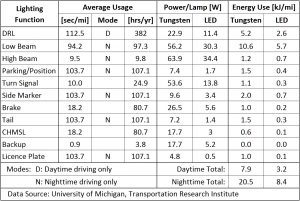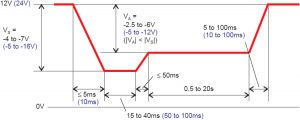The trend for the past decade in the automotive industry has been to move toward all solid-state implementation of vehicle lighting. LED headlight have only recently debuted and, with them, the first models to attain the all-LED goal.
Benefits of solid-state automotive lighting
LEDs bring a number of advantages over traditional tungsten-filament incandescent light sources. Improved luminous efficacy (lumens per watt) can produce energy savings, as shown in table 1, and hybrid-electric vehicles (HEVs) and electric vehicles (EVs) that place a high value on fuel economy exploit solid-state lighting devices to that end. However, vehicles built with traditional internal-combustion or diesel drive trains, which are somewhat less sensitive to energy savings, use some of the energy LED lighting saves to drive additional exterior lights, particularly markers and turn signals, which serve as both safety enhancements and differentiating elements of design style.

Incandescent bulbs are approximately 97% efficient as heaters. Current white LEDs offer luminous efficacy about 5x that of tungsten-filament bulbs, which means they generate substantially less heat for a given light output. So not only are the light emitters small, but their lower operating temperature and compatibility with common thermal management methods for electronics allow designers to arrange multiple elements packed closely together, providing valuable space savings, without generating excessively high temperatures that would negative affect operating lifetime.
Solid-state lights provide operating lifetimes that extend to tens of thousands of hours. Additionally, devices’ operating lives does not substantially degrade, as do incandescent bulbs, due to repeated on-off cycles common in several automotive applications. LEDs are also more robust in the presence of shock and vibration than incandescent bulbs.
Both of these traits play into the general trend automotive design has exhibited for several decades toward improved reliability, long component service life, and correspondingly longer maintenance cycles. The flip side is that fewer replaceable components are serviceable by the vehicle owner equipped with just a typical home tool kit, so long maintenance cycles are a necessary part of the ownership experience.
For example, some vehicle designs require partial disassembly of front body components to change a headlight every three or four years or every year or two in the case of high-brightness bulbs. Owners of such automobiles no doubt eagerly await the availability of LED headlights that could last the life of the car.
Lastly, LEDs bring important safety advantages over incandescent lighting in brake light and center high-mount stop light (CHMSL) positions. According to University of Michigan Transportation Research Institute studies, LEDs’ rapid rise times improve braking response time of following drivers by 170 to 200 ms (14 to 16 feet at 55 MPH) under favorable lighting conditions. Under adverse lighting conditions, with bright sunlight or high-intensity reflections on the brake light’s surface, the advantage increases to 300 ms (24 feet at 55 MPH).
Despite these numerous benefits, all-LED automobiles are only just now starting to emerge. Early applications include tail, brake, and marker lights—virtually any position that bright-red LEDs could serve. Second were backup lights and license-plate illuminators, which could tolerate the high color temperature and marginal color quality of early generation white LEDs. As white LEDs have improved in both light quality and manufacturers’ cost, the devices have succeeded in instrument clusters, cabin interiors, and, more recently, daytime running light (DRL) positions.
The headlight represents the LED’s final frontier in automotive lighting. It is the highest power and most complex automotive-lighting application. It is also the lighting position subject to the most stringent federal regulation.
Smart LED ballasts
Tungsten-filament bulbs model as resistors with positive temperature coefficients of resistance, so they are inherently stable when operating from simply bounded but otherwise unregulated voltage sources. By contrast, LEDs are current-operated devices—ideally, electrons in photons, out—and, therefore, require an electronic interface to serve, at minimum, as an regulated current source.
One could see the need for electronic intervention between the automobile’s electric power bus and its lighting devices as a negative when regarding LED lighting. However, thanks in part to advances in power-management ICs, new safety, performance, and convenience functions and enhancements compensate for the increase in lighting-system complexity. Indeed, LEDs in headlight positions will offer features that are simply impractical with traditional lighting technologies.
One example is in vehicles equipped with stop-start technology, which can add 4 to 8% to fuel mileage in passenger vehicles powered by internal-combustion engines simply by eliminating engine idle time. However, incandescent bulbs’ light output follows the applied voltage to the 3.4 power, so tungsten-filament headlights can dim by 30% during a stop interval, assuming a fully charged battery in good condition. Due to high battery current during cranking, incandescent headlights dim by as much as 92% during engine restart with a cranking pulse conforming to ISO7637-1, depicted in figure 1. LED ballasts designed with buck-boost power regulators can track out the battery voltage and maintain constant light output during stop-start cycles.

Intelligent ballasts can provide diagnostic information not available in tungsten-filament lighting systems. If equipped with a temperature sensor and thermally coupled to the load LEDs, a smart driver can compensate for the negative temperature coefficient of emitters’ luminous flux. For example, an LED’s light output can fall by as much as 30% as its junction temperature rises from 25 to 150°C.
To offer maximum design flexibility, power ballasts for automotive LED applications should be able to drive emitters in any of a vehicle’ lighting positions. Here again, programmable output current allows a single model IC to drive LED strings of varying lengths and output flux targets. This approach also allows automotive designers to take a platform-wide approach to lighting drive design, with the precise needs of individual vehicles met with model-specific software. Such designs also allow automakers to exploit advances in emitter design and manufacturing processes without the overhead costs associated with driver-hardware redesign cycles.
About the author:
Joshua Israelsohn directs JAS Technical Media’s technical-communication and technical-marketing practice. He holds an SBEE from Massachusetts Institute of Technology. His circuit-design experience is primarily in measurement, audio, embedded system, and power-management circuits. You can follow him on twitter: @Iz_Tech.


Leave a Reply
You must be logged in to post a comment.